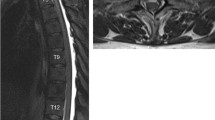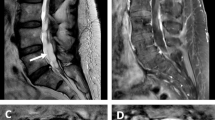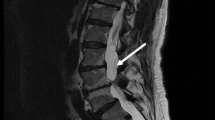Abstract
We present the radiological features of a 42-year-old man with long-standing inactive ankylosing spondylitis (AS), demonstrating that arachnoiditis is a cause of a cauda equina syndrome (CES) in this disease. CT showed a dorsal arachnoid diverticulum causing scalloped erosion of the laminae, and punctate and curvilinear dural calcification. MRI revealed adhesion and convergence of the cauda equina dorsally into the arachnoid pouch, causing the dural sac to appear empty canal. To the best of our knowledge, dural calcification on CT is a new finding in AS, which may be related to the CES. Our findings support the hypothesis that chronic adhesive arachnoiditis with subsequent loss of meningeal elasticity may be the main cause of CES in AS.
Similar content being viewed by others
Author information
Authors and Affiliations
Additional information
Received: 24 August 1998 Accepted: 2 December 1998
Rights and permissions
About this article
Cite this article
Bilgen, I., Yunten, N., Ustun, E. et al. Adhesive arachnoiditis causing cauda equina syndrome in ankylosing spondylitis: CT and MRI demonstration of dural calcification and a dorsal dural diverticulum. Neuroradiology 41, 508–511 (1999). https://doi.org/10.1007/s002340050793
Issue Date:
DOI: https://doi.org/10.1007/s002340050793




